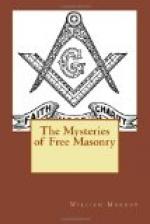Q. What were their dimensions? A. Eighteen cubits in height, twelve in circumference, and four in diameter.
Q. Were they adorned with anything? A. They were; with two large chapiters, one on each.
Q. Were they ornamented with anything? A. They were; with wreaths of net work, lily work, and pomegranates.
Q. What do they denote? A. Unity, Peace, and Plenty.
Q. Why so? A. Net work, from its connection, denotes union; lily work, from its whiteness and purity, denotes peace; and pomegranates, from the exuberance of its seed, denotes plenty.
Q. Were those columns adorned with anything further? A. They were; viz.: Two large globes, or balls, one on each.
Q. Did they contain anything? A. They did; viz.; All the maps and charts of the celestial and terrestrial bodies.
Q. Why are they said to be so extensive? A. To denote the universality of Masonry, and that a Mason’s charity ought to be equally extensive.
Q. What was their composition? A. Molten, or cast brass.
Q. Who cast them? A. Our Grand Master, Hiram Abiff.
Q. Where were they cast? A. On the banks of the river Jordan, in the clay ground between Succoth and Zaradatha, where King Solomon ordered these and all other holy vessels to be cast.
Q. Were they cast solid or hollow? A. Hollow.
Q. What was their thickness? A. Four inches, or a hand’s breadth.
Q. Why were they cast hollow? A. The better to withstand inundations or conflagrations; were the archives of Masonry, and contained the constitution, rolls, and records.
Q. What did you next come to? A. A long, winding staircase, with three, five, seven steps, or more.
Q. What does the three steps allude to? A. The three principal supports in Masonry, viz., Wisdom, Strength, and Beauty.
Q. What does the five steps allude to? A. The five orders in architecture, and the five human senses.
Q. What are the five orders in architecture? A. The Tuscan, Doric, Ionic, Corinthian, and Composite.
Q. What are the five human senses? A. Hearing, Seeing, Feeling, Smelling, and Tasting; the first three of which have ever been deemed highly essential among Masons: Hearing, to hear the word; Seeing, to see the sign; and Feeling, to feel the grip, whereby one Mason may know another in the dark as well as in the light.
Q. What does the seven steps allude to? A. The seven sabbatical years; seven years of famine; seven years In building the temple; seven golden candlesticks; seven wonders of the world; seven planets; but more especially the seven liberal arts and sciences, which are Grammar, Rhetoric, Logic, Arithmetic, Geometry, Music, and Astronomy; for these, and many other reasons, the number seven has ever been held in high estimation among Masons.
Q. What did you next come to? A. The outer door of the middle chamber of King Solomon’s Temple, which I found partly open, but closely tyled by the Junior Warden.




